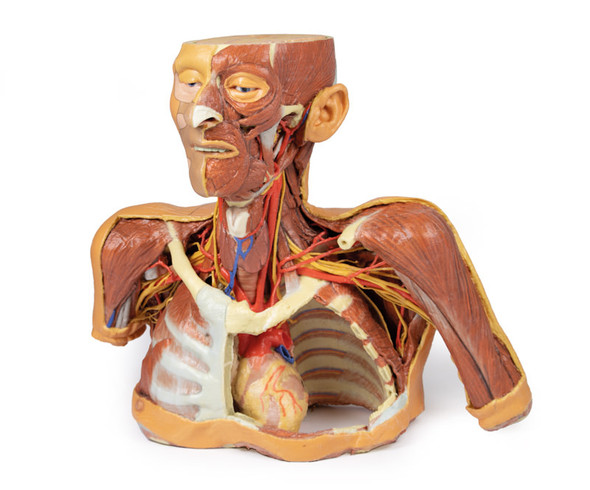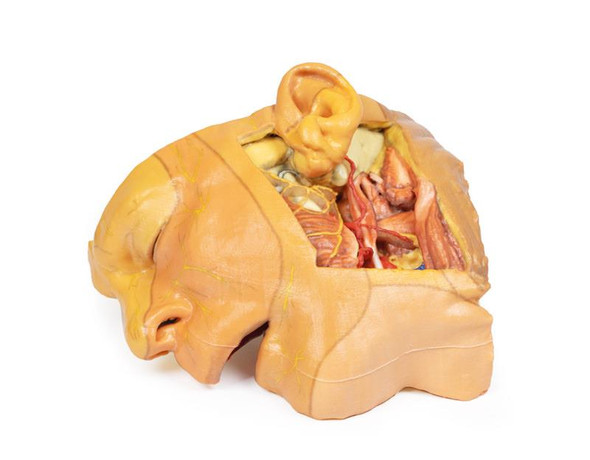Description
At the forefront of medicine and technology, we are proud to offer these incredible, uncompromised replicas of human anatomy. Using the latest 3D printing technology and materials available, this model is an exact replica of a human cadaver, brought to "life" by extensive medical scanning and manufacturing technologies. Over are the days of using ethically questionable cadavers, the mess of hazardous preservation chemicals, and the inaccuracies of plastinated models that often over-enhance anatomy for display, not realism. See the future, and the beauty, of real human anatomy with these incredible anatomical replicas!
This 3D print specimen preserves a series of features of the head and visceral column of the neck:
The face: On the right side of the head the parotid gland has been removed to reveal the facial nerve and all its branches (temporal, zygomatic, buccal, marginal mandibular and cervical) and demonstrate the spatial relations of structures embedded in the gland from superficial to deep (facial nerve, retromandibular vein, external carotid artery). In the surrounding region the temporalis, masseter and posterior belly of digastric are exposed, as are and the facial artery, transverse facial artery and superficial temporal artery. The facial vein and transverse facial vein are clearly visible uniting to form the common facial vein which is joined by the retromandibular vein to form the external jugular vein.
Viewed from the anterior aspect the face has been dissected to display some of the facial muscles around the mouth (buccinator [on the left], orbicularis oris and zygomaticus major). On the ledt side of the infratemporal fossa has been open to expose the medial and lateral pterygoids. The lateral pterygoid is divided to show the mandibular division of the trigeminal nerve dividing into the lingual nerve and the inferior alveolar branch. Also on the left side the branches of the ophthalmic division of the trigeminal that supply the skin above the eyebrows and scalp (supraorbital [left only] and supratrochlear nerves [both sides]) are dissected. The submandibular gland is clearly visible below the mandible on both sides as are the facial arteries and veins as they course over the mandible.
The neck: The musculoskeletal portion of the neck have been removed to display the pharynx posteriorly, the larynx anteriorly, and the neurovascular bundles laterally. The suprahyoid and infrahyoid muscles can be seen on the neck, as well as the cricothyroid muscle. When looking up the length of the trachea from below, the vocal folds are visible. The hypoglossal nerve can be seen winding around the lateral surface of the external carotid artery and the external branch of superior laryngeal nerve is seen descending in the neck. The internal jugular vein, the common carotid artery and its bifurcation into external and internal carotid arteries are clearly seen on both left and right. The vagus nerve in the carotid sheath is also visible. The ansa cervicalis is visible emerging below the digastric muscle and descending on the surface of the internal jugular vein. The internal branch of the superior laryngeal nerve can be seen below the superior thyroid artery on the left. The superior thyroid artery branching from the external carotid artery is seen descending in the anterior neck. The internal branch of the superior laryngeal artery is visible on the left piercing the thyrohyoid membrane above the inferior constrictor where this muscle is attached to the hyoid bone.
Posterior view of the pharynx: The superior, middle and inferior pharyngeal constrictors are indicated on the pharynx wall. The oesophagus can be identified emerging from the lower end of the pharynx. The posterior horn of the hyoid bone acts as a useful landmark. The carotid sheath seen from behind clearly shows the vagus nerve and its pharyngeal branches on the left. The recurrent laryngeal nerve is briefly visible on the left lying medial to the inferior thyroid artery. The occipital arteries are visible as they curve around the mastoid process. The vertebral arteries are seen either side of the brainstem as they enter the foramen magnum. The cerebellum has been removed to allow the fourth ventricle to be exposed. The cut surfaces of the cerebellar peduncles are clearly visible. A large portion of the posterior inferior cerebellar artery on the right is still visible as it winds around around the brainstem.
Cranial Cavity: The left and right orbits have been opened to reveal the orbital nerves and vessels along with the eyes and optic nerves. The optic chiasm, optic tracts and the lateral geniculate bodies are retained thus showing a large part of the visual pathways. The brainstem is cut at the level of the superior colliculi on the left and slightly lower on the right. The olfactory tracts and bulbs are also demonstrated. The origins of many of the cranial nerves from the brainstem are clearly visible.
Please Note: Thanks to the flexibility of manufacturing that 3D Printing offers, this model is "printed to order", and is not typically available for immediate shipment. Most models are printed within 15 working days and arrive within 3-5 weeks of ordering, and once an order is submitted to us, it cannot be canceled or altered. Please contact us if you have specific a specific delivery date requirement, and we will do our best to deliver the model by your target date.
Advantages of 3D Printed Anatomical Models
- 3D printed anatomical models are the most anatomically accurate examples of human anatomy because they are based on real human specimens.
- Avoid the ethical complications and complex handling, storage, and documentation requirements with 3D printed models when compared to human cadaveric specimens.
- 3D printed anatomy models are far less expensive than real human cadaveric specimens.
- Reproducibility and consistency allow for standardization of education and faster availability of models when you need them.
- Customization options are available for specific applications or educational needs. Enlargement, highlighting of specific anatomical structures, cutaway views, and more are just some of the customizations available.
Disadvantages of Human Cadavers
- Access to cadavers can be problematic and ethical complications are hard to avoid. Many countries cannot access cadavers for cultural and religious reasons.
- Human cadavers are costly to procure and require expensive storage facilities and dedicated staff to maintain them. Maintenance of the facility alone is costly.
- The cost to develop a cadaver lab or plastination technique is extremely high. Those funds could purchase hundreds of easy to handle, realistic 3D printed anatomical replicas.
- Wet specimens cannot be used in uncertified labs. Certification is expensive and time-consuming.
- Exposure to preservation fluids and chemicals is known to cause long-term health problems for lab workers and students. 3D printed anatomical replicas are safe to handle without any special equipment.
- Lack of reuse and reproducibility. If a dissection mistake is made, a new specimen has to be used and students have to start all over again.
Disadvantages of Plastinated Specimens
- Like real human cadaveric specimens, plastinated models are extremely expensive.
- Plastinated specimens still require real human samples and pose the same ethical issues as real human cadavers.
- The plastination process is extensive and takes months or longer to complete. 3D printed human anatomical models are available in a fraction of the time.
- Plastinated models, like human cadavers, are one of a kind and can only showcase one presentation of human anatomy.
Advanced 3D Printing Techniques for Superior Results
- Vibrant color offering with 10 million colors
- UV-curable inkjet printing
- High quality 3D printing that can create products that are delicate, extremely precise, and incredibly realistic
- To improve durability of fragile, thin, and delicate arteries, veins or vessels, a clear support material is printed in key areas. This makes the models robust so they can be handled by students easily.






























